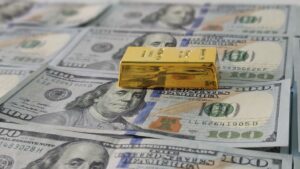Daily News Nuggets | Today’s top stories for gold and silver investors
October 15th, 2025
Gold Hits $4,200 — Making 2025 One of the Strongest Years in Gold History
Just one year ago, gold traded at $2,660. Today, it’s officially crossed $4,200 per ounce, marking one of the fastest and most powerful rallies in modern history.
The surge caps a 12-month run driven by central bank buying, global debt strains, and renewed fears over inflation and currency debasement. Traders are calling it a “new era” for gold as traditional models linking prices to real interest rates continue to break down.
Gold is now up about 58% year-over-year and 155% over the past three years — outperforming every major equity index in that span. With the Fed pivoting toward rate cuts and global confidence faltering, investors are increasingly treating gold not just as a hedge — but as a necessity.
Is this Bull Run Over? Dimon Says Gold Could Go to $5,000 – $10,000
JPMorgan CEO Jamie Dimon is adding fuel to gold’s rally. In an interview this week, he called the metal’s surge “semi-rational,” “It could easily go to $5,000, $10,000 in environments like this.”
Dimon pointed to structural inflation, record U.S. deficits, and waning confidence in fiat currencies as key catalysts. “If you’re not holding some gold right now,” he added, “you’re missing an important insurance policy.”
Markets took notice: gold futures volume spiked 40% above average, and major miners gained another 6%. Analysts say Dimon’s comments mirror what central banks have been signaling for months — that fiat risk is rising and gold is re-emerging as the world’s ultimate reserve asset.
JPMorgan’s commodity desk has maintained a bullish stance since summer, citing strong central bank demand and tightening supply from major producers. “Even if inflation eases, the debt dynamics don’t,” one strategist noted, pointing to the U.S. government’s annual interest expense, now above $1.2 trillion.
EU’s Ukraine Funding Plan Could Spur More Central Bank Gold Buying
The European Union’s plan to tap €185 billion in frozen Russian state assets to fund Ukraine is raising fresh alarm among central bankers — and could accelerate a global pivot toward gold reserves held outside Western vaults.
While the plan avoids outright confiscation, analysts say it reinforces a troubling reality: sovereign reserves stored abroad are no longer risk-free. “The effect is the same — Russia has been denied access to its own money,” said gold analyst Ross Norman. “Central bankers know this and are acting accordingly.”
Since 2022, central banks have been buying over 1,000 tons of gold annually — double the five-year average — with Metals Focus forecasting another 900 tons this year. Gold has even surpassed the euro as the world’s second-largest reserve asset, trailing only the U.S. dollar. That erosion of trust in the Western financial system isn’t limited to currencies. Governments are increasingly flexing control over strategic commodities as well.
China Tightens Grip on Rare Earths — And the West Has Few Options
China has imposed sweeping new controls on seven key rare earth metals, rattling global markets and reigniting fears over resource dependence. The new rules require foreign firms to obtain Beijing’s approval before exporting any products containing Chinese-sourced rare earths — materials critical for EVs, semiconductors, and defense systems.
With China controlling roughly 70% of global refining, the move underscores Beijing’s leverage over high-tech supply chains. Washington and Brussels are scrambling for alternatives, but reducing that dependence will take years — and billions in investment.
For investors, the takeaway is clear: when governments weaponize supply chains, the assets you hold directly become more valuable. Gold and silver can’t be embargoed, confiscated by decree, or cut off by export controls. It’s not just gold and geopolitics facing disruption — silver is showing similar cracks across global markets.
Silver Market 2025: What’s Behind the $8 East–West Price Gap
Something extraordinary is happening in silver. The East–West price gap has widened to nearly $8 per ounce, with Chinese buyers paying record premiums for physical metal while Western exchanges still quote far lower “paper” prices.
Lease rates have surged to 33%, signaling a global shortage and a scramble among short sellers to cover positions. Traders are literally flying silver bars across the Atlantic to fill supply holes in London. If the imbalance continues, the physical market — not COMEX — could soon dictate the global price.
Under normal conditions, those rates hover near zero. A 33% spike reveals a market starved of liquidity. For short sellers, it’s a nightmare: soaring financing costs, scarce metal, and mounting pressure to buy back ounces — adding even more demand to an already strained system.
Mike Maloney and Alan Hibbard unpack the full story in their latest video: “Global Silver Shortage: Why the Physical Price Is Breaking Away From Paper.”



![Is Now the Best Time to Buy Silver? [Silver 2025–2030 Forecasts]](https://goldsilver.com/wp-content/uploads/2025/11/price-of-silver-300x155.jpg)


